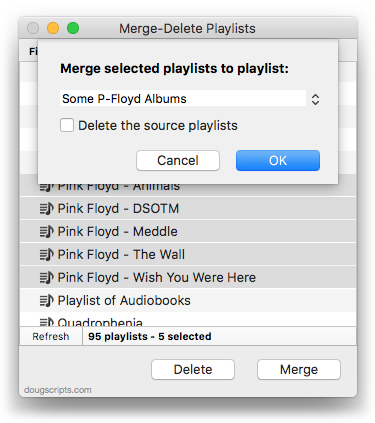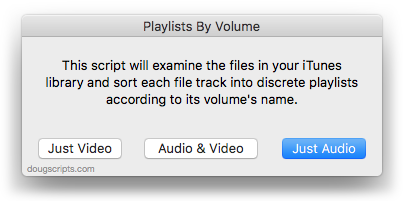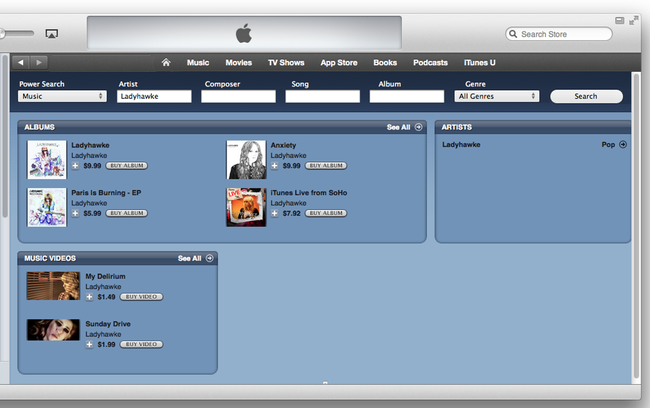UPDATED: Merge-Delete Playlists v3.3
Merge-Delete Playlists will allow you to merge the track contents of two or more playlists or delete any number of playlists at once, including Smart, Genius, and Playlist Folder playlists. The merge feature will prevent the same tracks that may appear in different source playlists from being duplicated and has an option to delete original playlists. The delete feature only deletes the playlist; tracks, of course, remain in the library.

This latest version fixes issues running under Mavericks and fixes a problem re-enabling after a delete operation.
More information and download is here.
Genius Playlists Can Be Shuffled
So I just discovered that everytime I play a Genius playlist it plays in the same order. My guess is that everybody else already knew that.
Today, however, I discovered that if you place a Genius playlist inside a Playlist Folder and then select the Playlist Folder, set it to shuffle, and then play, the songs play shuffled. That is, the tracks play in a different random order each time the Playlist Folder containing the Genius playlist is played.
When I told Kirk McElhearn about this he imagined that one could create several Genius Playlists based on the same Artist seed in order to maximize variety. So I tried that. And here's what's cool:
My presumption was that two (or more) Genius Playlists based on a similar seed each might contain duplicate tracks which would therefore be duplicated in the Playlist Folder that I put them in. But they are not. While the two Genius Playlists show 100 songs each, the total of tracks for the Playlist Folder is 174; the duplicate tracks don't "register" in the Playlist Folder context.
I like this because I can maintain the Genius playlists longer without having to refresh or recreate them.
OS X 10.9.3 Update Hides Users Folder
Many users updating to OS 10.9.3 are reporting that their /Users folder is set to be hidden, not unlike how the ~/Library folder is hidden by default. However, this behavior is not happening to everyone, including me (but I have only updated one machine).
Perhaps needless to say: installing AppleScripts into any of the appropriate folders in the Users directory will be somewhat impeded by this phenomenon.
Bug or feature characterizations aside, if your Users folder is hidden after installing OS X 10.9.3, several people are suggesting resetting the "hidden" flag of the folder; but this flag is evidently re-set back to hidden on a restart of the machine. A relatively more thorough fix is suggested on the French MacBidouille forum and is also listed in the comments of Chris Breen's Unhiding the Users folder article at MacWorld. This fix has you reset PRAM, repair permissions, and then reset permissions on the Users folder.
Among other workarounds: From the Finder's "Go" menu click "Go to Folder..." and type in "/Users". Once open, drag the folder icon in the title bar to the "Favorites" section in the window's sidebar. The folder will continue to be hidden in the Finder but can now be accessed from the sidebar.
UPDATE: According to The Mac Observer this issue is related to having Find My Mac enabled and the iTunes 11.2 update and not specifically the OS X 10.9.3 update.
UPDATE ALSO: Apple fixed the issue in the iTunes 11.2.1 release on May 17.
Apple Releases iTunes 11.2
iTunes 11.2 is out and primarily fixes some Podcast management features, fixes unresponsive Genius updating (I had that!), and (as usual) improvements to overall performance and stability.
NEW: Playlists By Volume v1.0
Had to round up some files located on disparate drives, but iTunes tracks can't be sorted using any file path information.
Playlists By Volume will sort the tracks of your iTunes library into discrete playlists based on the volume name of each track's file's location.

Takes about a minute per thousand tracks to complete.
More information and download is here.
Reveal Multiple Selected Tracks' Files
I occasionally have need to access the files of tracks that may not always be in the same "Album" folder. iTunes has a "Show in Finder" command (Shift-Command-R) for single tracks so to reveal all the files from disparate folders I have to "Show in Finder" each of the tracks, one at a time.
But what if I could open each selected track's file's folder in its own tab in a single Finder window? Like this:

Each tab is the containing folder for the file of each selected track and each file is highlighted. Even if two or more files are in the same folder the folder will get its own tab for each file.
The script follows:
(more…)
iTunes 11.1.5 Released
Apple has released iTunes 11.1.5 which fixes a problem with unexpected quits while connecting a device and improves compatibility with iBooks. Not sure what issues with iBooks are addressed.
NEW: Scan For Double Entries
A funny thing started happening shortly after the introduction of iTunes 11 a few months ago. I began getting reports from Correspondents about usually reliable scripts that weren't working correctly. After closer scrutiny, we were able to determine that some of their media files were appearing twice in the library. That is, they were finding pairs of identical tracks in the "Music" library that each pointed to the same file. Like this:

Two "Music" track entries, same file.
This is not ever supposed to happen. iTunes should not allow a file in a unique location to be added to its library more than once.
Now, this is not the same effect as copying a library track two or more times to a playlist, whereby only one library track is involved. Nor is it the same as when iTunes appends a number to a filename to distinguish it from an earlier-added same-named file. Nor do these tracks seem to be a flavor of iTunes Match duplicates (iTunes Match may or may not be a factor in their appearance). This issue manifests as sets of two distinct library track entries, each having different IDs and both having the same value for the Location property.
I don't know how this happens. But it definitely has something to do with moving media files around the wrong way and doing so with iTunes 11. It may be a bug and it may even be fixed by now. But I don't know. I only got it to happen once myself while I was experimenting convolutedly with a different issue and I haven't been able to replicate it since.
Regardless of how these pairs came to be, how now to find them and then to deal with them? If you have a very large library, you may not even notice if you have any faux pairs.
My duplicate removal apps, Dupin and Dupin Lite, can detect this condition but won't attempt to delete any files. If the file of one of the tracks were deleted, well, then neither track would be pointing to a file any longer and you'd have a lot of dead tracks. There's a trick to using Dupin to delete an arbitrary one of each of the track pairs, but, technically, they're not the sort of "dupes" that Dupin wants to handle.
So, the applet Scan For Double Entries simply looks through your library for track entries that have the same file path (that is, the same file location) and will copy these pairs of tracks to a discrete playlist so you can sort them out yourself. Presumably you'll want to delete one of the tracks in each faux pair and I'm not sure that's something you want an automated tool to do for you, you know, automatically.
More information and download is here.


